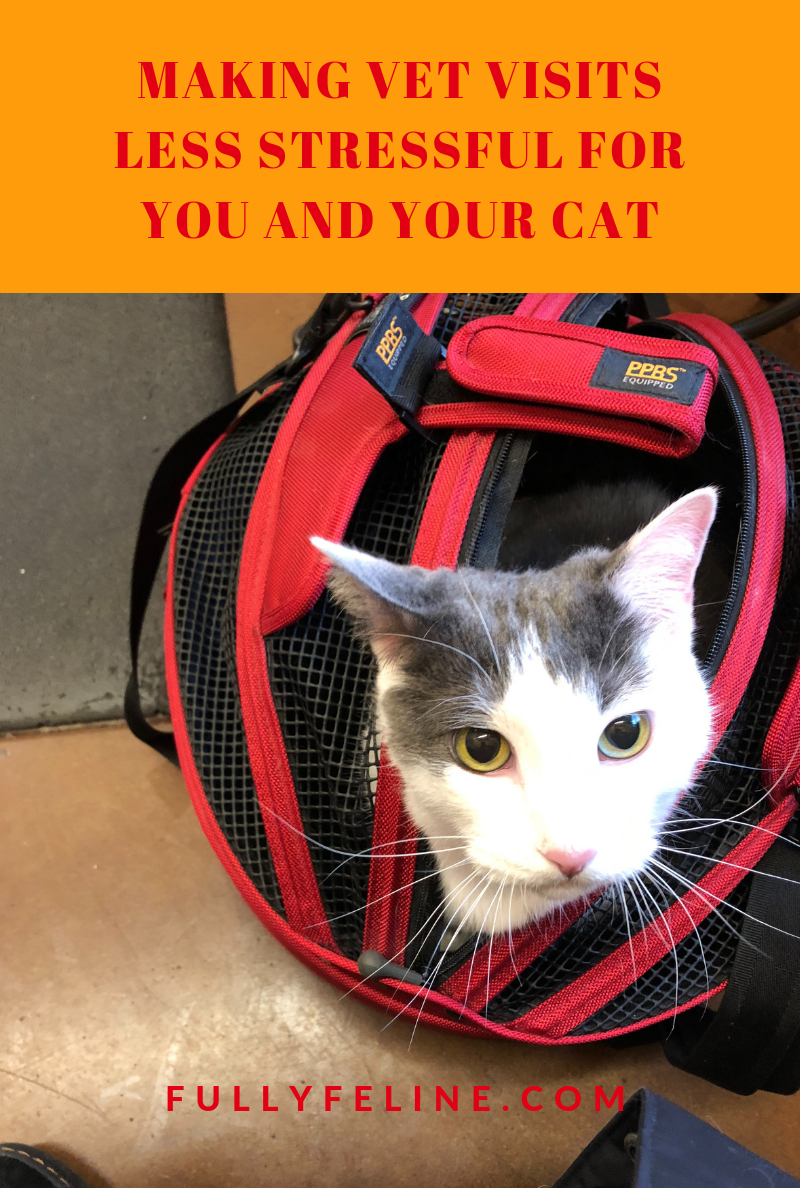Going to the doctor is no fun, and your cat is probably really scared when he sees the signs that a vet visit is coming up for him. Marty had a vet appointment last week and although a bit stressful for him, he did pretty well.
I totally get that, I’m terrified of doctors, too! It can be quite a process preparing your cat for his vet visit. Although it’s impossible to remove all stress from the experience, there are some steps you can take to make vet visits for cats less scary.
Disclaimer: This post contains an affiliate links. We receive a small commission on goods featured via these links, at no additional cost to you.

Look for a Cats-only Clinic
The sights, sounds and smells in a vet’s office are scary enough for cats, but the anxiety worsens if they have to share the waiting room with dogs.
If there isn’t a cats-only clinic in your area, look for a clinic that has separate waiting areas for cats.
Help Your Cat Become Comfortable With His Carrier
If you don’t take your cat to the vet frequently, he will probably come to associate his carrier with vet visits. Here are some suggestions to help him become comfortable with his carrier:
- Put the Carrier in a Room You Use Often. Keep the door of the carrier open and treat it as part of the furniture.
- Add some Comfortable Bedding, Catnip, or your Cat’s Favorite Treats.This will help your cat realize his carrier can be a fun place to hang out.
- If your cat will eat inside his carrier, feed him there daily. For those not comfortable eating there, feed near the carrier and gradually move the food dish closer until he will go inside.
- Once your cat becomes comfortable with eating in the carrier, teach him the “in” command. Put a treat in the carrier and when your cat goes in, say “in.” Praise him while he’s in there. When he comes out, toss in another treat and repeat. Eventually, when say “in,” your cat should go into the carrier on his own. Give him a treat after he goes in, while he’s still in the carrier. This shows him going into the carrier can be fun, and rewarding!
- Carriers like the Sleepypod Mobile Pet Bed (featured in picture of Marty above) can help relieve some of the stress for cats. Designed to serve as a bed in addition to a carrier, and lined with a soft furry padding, cats get used to it for napping first.
Try Pheromones
Add pheromones such as Rescue Remedy to your cat’s treat or water beginning a day or two before the vet visit. This will provide a calming effect leading up to putting him in his carrier and the trip that follows. Rescue Remedy comes in drop form and can be applied directly to your cat’s skin.
Also, spraying a pheromone such as Comfort Zone on carrier bedding before taking your cat to the vet can help calm him during the trip and vet visit.
Minimize Waiting Room Time
To minimize time spent in the waiting room, schedule your cat’s appointment for the morning, or right after the doctor’s lunch. Marty’s appointment was at 9:30 a.m. Try not to schedule on Saturdays or weekday evenings after 5, since both of those slots are usually very busy.
During our visit last week, the staff person took us directly to a “cat room” outfitted with a couple of big windows, shelves for perching, a pheromone diffuser and a fish tank.
Avoid Waiting Room Altogether
If your cat tends to get very panicky in the waiting room, wait in the car with him. Ask the receptionist to call you when the doctor is ready to see your cat.
Know Your Cat’s Window Of Opportunity
Some cats relax after taking time to checkout the exam room. Other cats become more anxious the longer the time in the room. If you know your cat’s window of opportunity, share this with your vet.
Discuss information with your vet after your cat is back safely in his carrier. This can help minimize your cat’s stress during the visit.
Consider House Calls
Another alternative to consider is house calls. Check with your vet to see if he/she makes house calls. We have a mobile vet that also visits your home. These options will cost more, but may be worth investigating for cats prone to extreme anxiety, or a chronic condition requiring frequent vet visits.
Conclusion
Marty wasn’t really comfortable during the vet visit, but the few extra steps helped ease his anxiety. I am terrified of the doctor’s office, so totally understand why vet visits for cats are so stressful for them.
Using the tips above won’t erase stress totally, but will make the experience easier for you and your cat.





